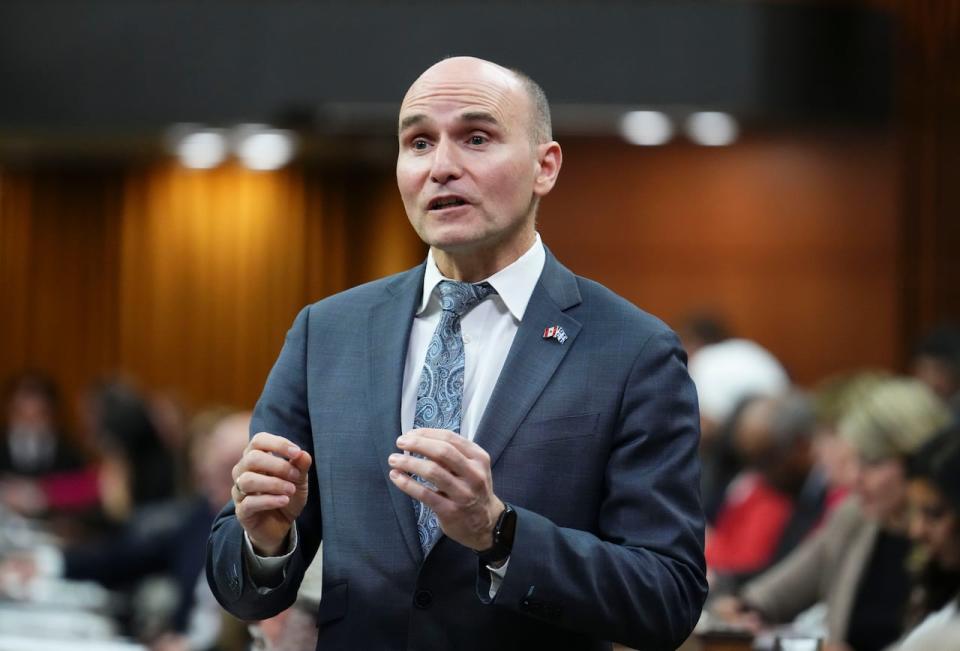A device that federal officials call “the little robot” appeared in Gatineau office buildings in March.
According to Yahya Saad, co-founder of GlobalDWS, which created the robot, it travels around the workplace collecting data using about 20 sensors and a 360-degree camera.
“Using AI on the robot, the camera takes the photo, analyzes and counts the number of people and then discards the image,” he said.
Part of a platform known as VirBrix, the robot also collects information on air quality, light levels, noise, humidity, temperature and even measures CO2, methane and radon gas.
We believe that one of the robot’s tasks is to monitor who is there and who is not. – Bruce Roy, Public Service Union
The goal is to create a better working environment for people – an environment that is not too hot, humid or dark. Saad said this means more comfortable and productive employees.
The technology can also help reduce heating, cooling and hydropower costs, he said.
“All these measures have been taken to save energy and reduce the ecological footprint,” Saad explains.
After the pilot program in March, VirBrix will return in July and October, and the government has not ruled out expanding its use. It will pay $39,663 to lease the robot for two years.
Officials feel they are being spied on
Bruce Roy, national president of the Government Services Union, called the robot’s presence in federal workplaces “intrusive” and “offensive.”
“People feel constantly observed,” he said in French. “It’s a spy. The robot is a spy for management.”
Roy, whose union represents more than 12,000 federal employees across several departments, said the robot is unnecessary because the employer already has ways to monitor employee attendance and performance.
“We believe that one of the robot’s jobs is to monitor who is there and who is not,” he said.
“People say: why is there a robot here? Doesn’t my employer trust me to be here and do my job well?”

Bruce Roy, national president of the Government Services Union, called the robot “invasive” and “offensive.” (Radio Canada)
As the federal government prepares to require civil servants to return to the office three days a week, Roy used the robot as a means to monitor employees rather than create a positive work environment.
In addition, the union is concerned about the data the robot collects, how it will be used and where it will be stored.
“The robot can learn intimate details of our routines,” he said. “For example, our laundry room is breaking down.”
According to Roy, the union is particularly concerned because of a previous collision with sensors installed at employees’ workplaces between January 2022 and March 2024.
PSPC spokesperson Jean-Pierre Potvin confirmed that 208 devices with motion and infrared sensors collected data on “the frequency and duration of use in the workplace.”
The sensors cost the government $72,000.
Minister calls robots a tool to improve the workplace
The federal government denies that the robot had anything to do with getting workers into the office three days a week in September.
Jean-Yves Duclos, the minister of public services and procurement, said the government is using the technology instead as it aims to halve the footprint of office space in the coming years.
“These robots, as we call them, these sensors observe the use of office space and in the coming years will be able to give us information to better provide the kind of workplace that employees need to do their work,” Duclos said in French.
“These are completely anonymous methods that allow us to evaluate which spaces are most used and which spaces are not used, so that we can better organize them.”


Minister of Public Services and Procurements Jean-Yves Duclos responds to a question during question time in the House of Commons on February 12. (Sean Kilpatrick/The Canadian Press)
Saad has a simple answer to the fear of surveillance.
“It’s not a spy,” the GlobalDWS co-founder said, explaining that it does not collect information that could identify individual employees.
“It only measures environmental health and safety measures, and the number of people in a room,” he said.
While the robot typically deletes images quickly after taking them, Saad acknowledges that there are rare cases where employers ask the company to keep them.
“In those cases, we keep the images, but the whole body, not just the face, the whole body of the person is blurred,” he said. These are exceptional cases where we have to store images and the images are then transferred to the customer.”
The data is then stored on a server on Canadian soil, according to GlobalDWS.
Employees were treated ‘like furniture’, researcher says
Given the mistrust some officials have toward the robot, researcher Pierrot Péladeau says the government appears to be treating its employees “a bit like furniture.”
Péladeau, a consultant in the field of social assessment of information systems, doubts the quality of the data that the robot will produce.
He said employees may decide to “play with the robot” and behave differently in its presence simply to tamper with the data it collects.
“They make a great Swiss cheese,” he said in French. “There are a lot of holes.”
Furthermore, if the robot keeps the data anonymous and doesn’t know who is in the office, it can only do so much to create a comfortable workplace. People have different preferences for temperature, lighting or humidity, Péladeau noted, so it will be difficult to keep employees happy without knowing factors like their gender and age.
He suspects that the data is not really anonymous. The system can spit out a report without identifying anyone, but that does not mean that employees cannot in principle be identified.
“If I know that there is a meeting at such a time… or that a person has to work in this workplace, it is clear that this information is about an identifiable individual,” he said.
“If the employer receives the information directly, there is an opportunity to identify the person.”